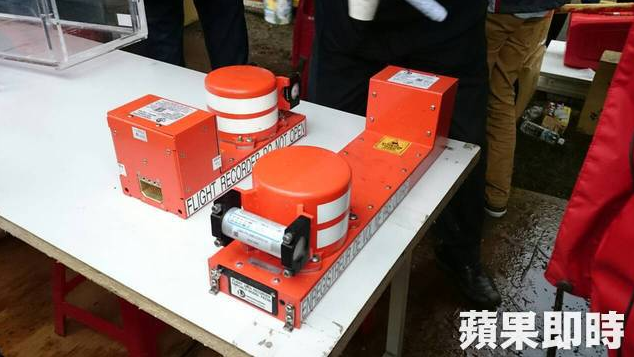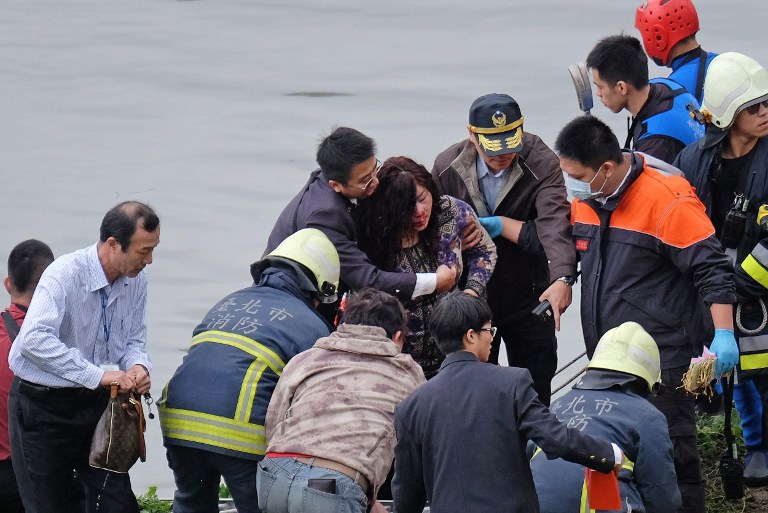At least 25 dead after TransAsia plane plunges into Taipei river
 The black boxes recovered from the TransAsia Airways plane that clipped a road bridge and plunged into a river in Taiwan. (Photo: Apple Daily) |
TAIPEI: At least 25 people were killed on Wednesday (Feb 4) when a passenger plane operated by TransAsia Airways clipped an overpass soon after take-off and plunged into a river in Taiwan, the airline's second crash in seven months.
As the rescue operation continued into the night, a crane lifted the rear and central sections of the plane from the water, with one body retrieved from inside. The front part, where 17 people are believed to be trapped, was still in the water.
TransAsia said 16 survivors had been pulled out of the wreckage after the turboprop plane crashed with 58 people onboard. Many of the passengers were mainland Chinese tourists. Cold weather, poor visibility and rising water levels were hampering the rescue, officials said, admitting they were now "not optimistic" about finding survivors.
Dramatic amateur video footage showed the TransAsia ATR 72-600 hit an elevated road as it banked sidelong towards the Keelung River, leaving a trail of debris including a smashed taxi.
"I saw a taxi, probably just metres ahead of me, being hit by one wing of the plane. The plane was huge and really close to me. I'm still trembling," one witness told TVBS news channel. An AFP reporter at the scene saw bodies being pulled from the wreckage into the early evening.
Desperate crew shouted "Mayday! Mayday! Engine flameout!" according to a recording thought to be the final message from the cockpit to the control tower played on local television. A "flameout" is when the flame that normally burns in the engine goes out, causing engine failure. Twin-engined planes are usually able to fly on one engine. Aviation officials said they had not released the cockpit recording, suggesting that it may have come from amateurs monitoring the radio.
An AFP reporter at the scene said he had seen bodies being pulled from the wreckage into the early evening.
"An engine flameout refers to the engine shutting down in flight," said Daniel Tsang, founder of Hong Kong-based aviation consultancy Aspire Aviation. "The engine stops producing thrust and the combustion process fails and no longer generates any forward propulsion to the aeroplane."
But Tsang told AFP that pilots were "very well trained" to deal with the failure of one engine and the causes of the crash were likely to be more complex.
It was the second fatal crash involving a TransAsia Airways plane within a few months. A flight operated by the domestic airline crashed in July during a storm, killing 48 people.
RACING AGAINST TIME
Wednesday's accident happened just before 11:00am (0300 GMT), shortly after Flight GE235 left Songshan airport in northern Taipei en route to the island of Kinmen, with 58 people on board including five crew members.
Six airline officials including chief executive Peter Chen bowed in apology at a televised press conference. "We would like to convey our apologies to the families (of the victims) and we'd also like to voice huge thanks to rescuers who have been racing against time," said Chen.
"TransAsia Airways will do its utmost to help our passengers, the injured, as well as the families of the passengers on board. We will deploy all our resources to help in the rescue efforts as well as in the aftermath of this incident," said Chen.
Lin Kuan-cheng from the National Fire Agency later said that 14 people were dead and nine showing "no signs of life" - the term used before death is officially confirmed. "As it has been a while and the weather is cold, things are not optimistic, but rescuers will do everything to find and rescue the remaining missing people," Lin added. Those missing are thought to be trapped inside the submerged front section of the plane.
A crane is being brought in to lift the wreckage. "Rising water levels and poor visibility underwater has made the work very difficult," said senior rescue official Wu Chun-hung.
There has been no official comment on the cause of the crash, but the black boxes have been retrieved.
Several former pilots told local media that the plane's sideways flip while in the air could have been caused by the failure of one of the engines.
DESPERATE RESCUE
As time ticked away for those inside the fuselage, rescue boats surrounded the wreckage which remains in the middle of the river, with 400 soldiers drafted in to help. With night falling, lighting equipment was brought in and rescuers began trying to cut open the fuselage with electric saws. A floating bridge was set up between the plane and the shore.
Earlier in the day survivors had been ferried to shore in dinghies as rescuers tried to pull people out with ropes.
 An injured passenger (C) is helped onto land by emergency personnel along the river bank after a TransAsia ATR 72-600 turboprop plane crash-landed into the Keelung river outside Taiwan's capital Taipei on Feb 4, 2015. (Photo: AFP/Sam Yeh) |
China's Xiamen Daily said on its social media account that the 31 mainlanders on board were part of two tour groups from the eastern Chinese city. Xiamen is in Fujian province, which lies across the Taiwan Strait from the island.
An employee of one of the tour agencies, surnamed Wen, told AFP that it had 15 clients on board, including three children under 10, and a tour leader. "It's an emergency," she said. "We're working with different work teams. We're trying to arrange for the relatives to go to Taiwan." TransAsia's Chen said that of the 31 passengers from the mainland, three were children.
Aviation officials said the plane crashed minutes after taking off Songshan airport, after losing contact with the control tower. Lin Chih-ming, head of Taiwan's Civil Aeronautics Administration, said the ATR 72-600 was less than a year old and was last serviced just over a week ago.
The pilot had 14,000 flying hours and the co-pilot 4,000 hours, Lin said. The airline said they had received the plane in April last year and it was the newest model of the ATR.
In last July's crash, the 48 people were killed when another domestic TransAsia flight crashed onto houses during a storm on the Taiwanese island of Penghu.
Footage taken from TVBS shows the plane hitting a vehicle while passing close to a highway.
Unverified images from a Twitter user in Taiwan have shown images of the plane flying close to a highway and going almost sideways before it hit the river.
What the stars mean:
★ Poor ★ ★ Promising ★★★ Good ★★★★ Very good ★★★★★ Exceptional
Latest News
More News
- 72 nations sign landmark Hanoi cybercrime convention (October 26, 2025 | 18:00)
- UN Secretary-General commends Vietnam’s global leadership (October 26, 2025 | 09:00)
- APEC finance ministers convene to tackle regional challenges (October 22, 2025 | 17:31)
- Rewiring global trade: ASEAN’s rise as supply chain hub (October 17, 2025 | 11:40)
- Vietnam attends first World Nuclear Week Forum in Russia (September 26, 2025 | 10:50)
- Vietnam attends 69th session of IAEA General Conference (September 16, 2025 | 10:00)
- ADB, WB pledge over 12 billion USD for ASEAN power grid, renewable energy projects (August 15, 2025 | 14:18)
- Lowy Institute proposes AI-based tobacco control solutions for ASEAN (August 15, 2025 | 14:14)
- Cloud computing policy to position Malaysia as regional hub by 2030 (August 15, 2025 | 14:11)
- Thailand, Cambodia suffer numerous cyber attacks (August 05, 2025 | 16:19)

















 Mobile Version
Mobile Version